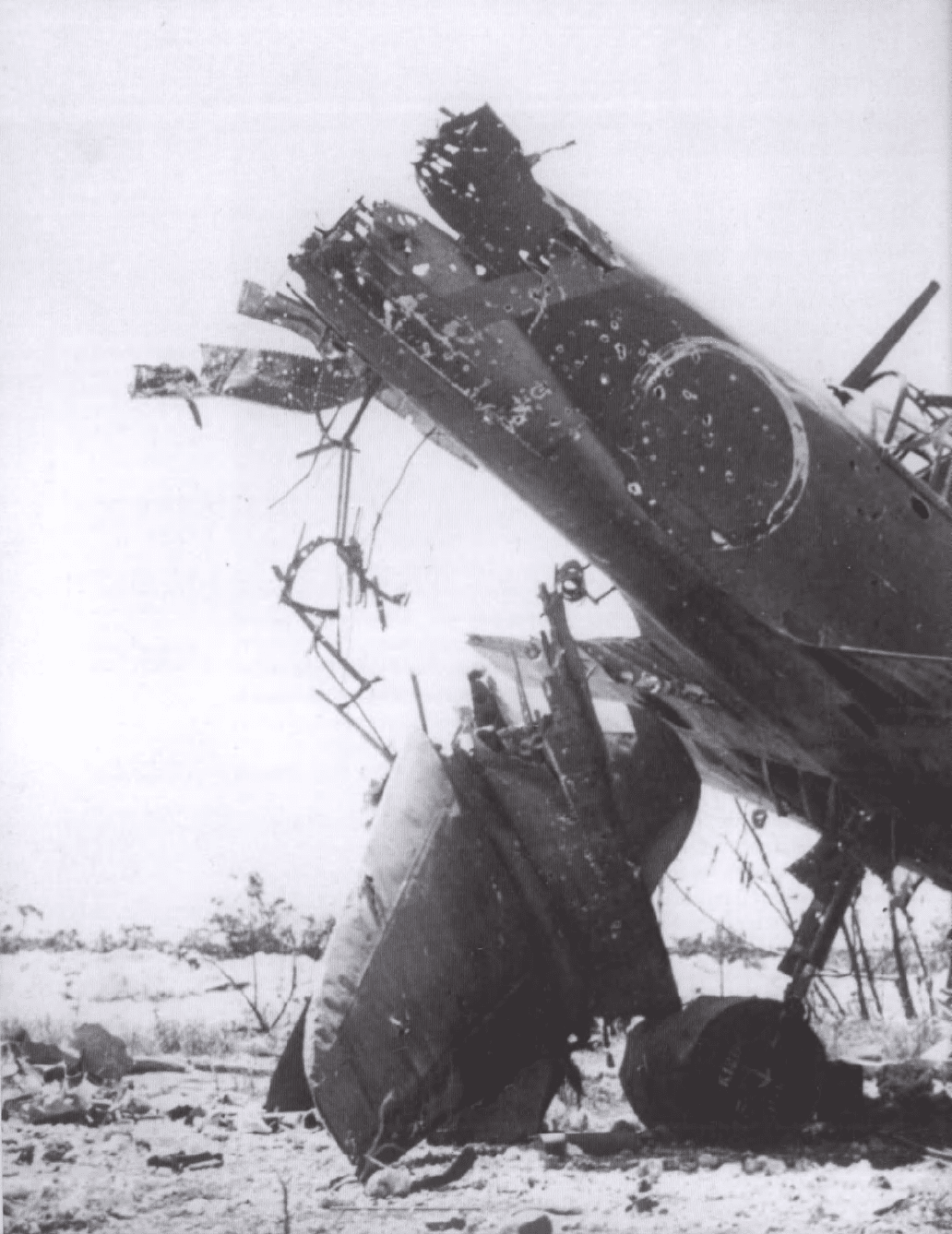Dye Dale, O`neill Robert. The road to victory: From Pearl Harbor to Okinawa
Подождите немного. Документ загружается.

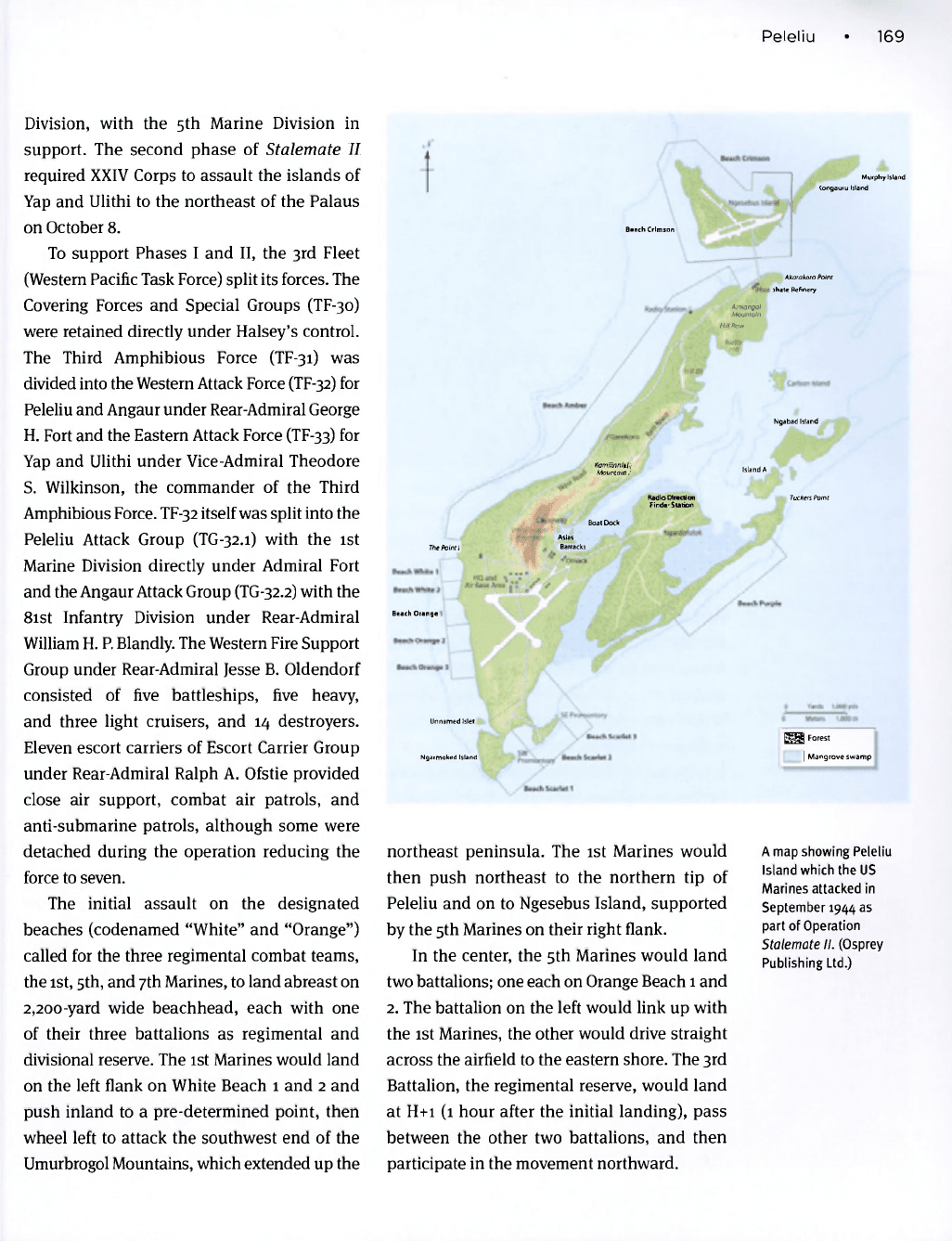
Peleliu • 169
Murphy Island
(ongauru Island
Beach
Crimson
Akarakoro Point
jhate Refinery
Amiangal
Mountain
Hill Row
Ngabad Island
'KarhlliaMj
Mountain,'
Island A
Radio
Direction
Finder
Station
Tuckers Point
Boat Dock
Asias
Barracks
The
Point i
Beach Orange
ESJ Forest
| Mangrove swamp Ngarmoked Island
Division, with the 5th Marine Division in
support. The second phase of Stalemate II
required XXIV Corps to assault the islands of
Yap and Ulithi to the northeast of the Palaus
on October 8.
To support Phases I and II, the 3rd Fleet
(Western Pacific Task Force) split its forces. The
Covering Forces and Special Groups (TF-30)
were retained directly under Halsey's control.
The Third Amphibious Force (TF-31) was
divided into the Western Attack Force (TF-32) for
Peleliu and Angaur under Rear-Admiral George
H. Fort and the Eastern Attack Force (TF-33) for
Yap and Ulithi under Vice-Admiral Theodore
S. Wilkinson, the commander of the Third
Amphibious Force. TF-32 itself was split into the
Peleliu Attack Group (TG-32.1) with the 1st
Marine Division directly under Admiral Fort
and the Angaur Attack Group (TG-32.2) with the
81st Infantry Division under Rear-Admiral
William H. P. Blandly. The Western Fire Support
Group under Rear-Admiral Jesse B. Oldendorf
consisted of five battleships, five heavy,
and three light cruisers, and 14 destroyers.
Eleven escort carriers of Escort Carrier Group
under Rear-Admiral Ralph A. Ofstie provided
close air support, combat air patrols, and
anti-submarine patrols, although some were
detached during the operation reducing the
force to seven.
The initial assault on the designated
beaches (codenamed "White" and "Orange")
called for the three regimental combat teams,
the 1st, 5th, and 7th Marines, to land abreast on
2,200-yard wide beachhead, each with one
of their three battalions as regimental and
divisional reserve. The 1st Marines would land
on the left flank on White Beach 1 and 2 and
push inland to a pre-determined point, then
wheel left to attack the southwest end of the
Umurbrogol Mountains, which extended up the
northeast peninsula. The 1st Marines would
then push northeast to the northern tip of
Peleliu and on to Ngesebus Island, supported
by the 5th Marines on their right flank.
In the center, the 5th Marines would land
two battalions; one each on Orange Beach 1 and
2. The battalion on the left would link up with
the 1st Marines, the other would drive straight
across the airfield to the eastern shore. The 3rd
Battalion, the regimental reserve, would land
at H+i (1 hour after the initial landing), pass
between the other two battalions, and then
participate in the movement northward.
A map showing Peleliu
Island which the US
Marines attacked in
September 1944 as
part of Operation
Stalemate II. (Osprey
Publishing Ltd.)
Unnamed Islet
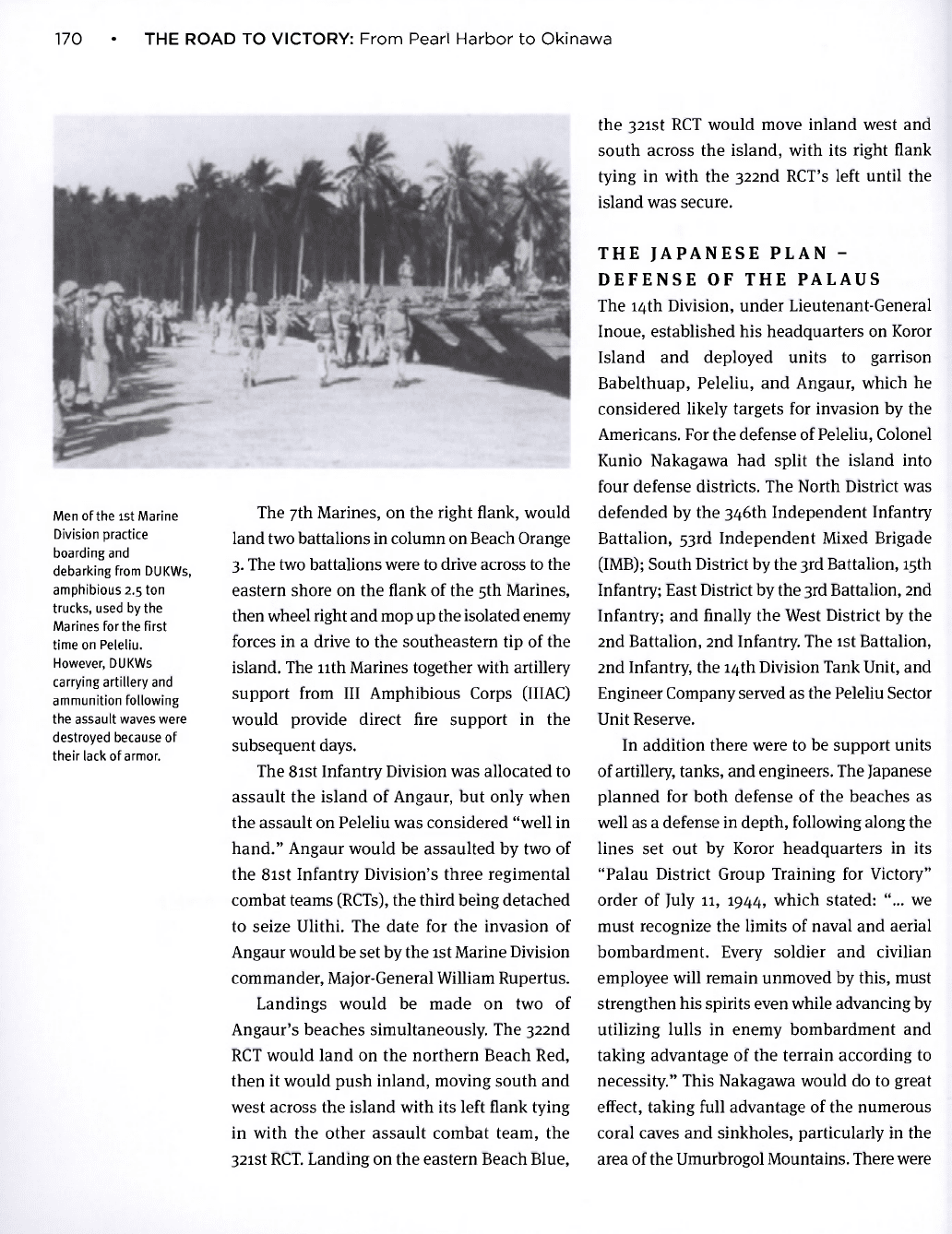
170 • THE ROAD TO VICTORY: From Pearl Harbor to Okinawa
The 7th Marines, on the right flank, would
land two battalions in column on Beach Orange
3. The two battalions were to drive across to the
eastern shore on the flank of the 5th Marines,
then wheel right and mop up the isolated enemy
forces in a drive to the southeastern tip of the
island. The 11th Marines together with artillery
support from III Amphibious Corps (IIIAC)
would provide direct fire support in the
subsequent days.
The 81st Infantry Division was allocated to
assault the island of Angaur, but only when
the assault on Peleliu was considered "well in
hand." Angaur would be assaulted by two of
the 81st Infantry Division's three regimental
combat teams (RCTs), the third being detached
to seize Ulithi. The date for the invasion of
Angaur would be set by the 1st Marine Division
commander, Major-General William Rupertus.
Landings would be made on two of
Angaur's beaches simultaneously. The 322nd
RCT would land on the northern Beach Red,
then it would push inland, moving south and
west across the island with its left flank tying
in with the other assault combat team, the
321st RCT. Landing on the eastern Beach Blue,
Men of the 1st Marine
Division practice
boarding and
debarking from DUKWs,
amphibious 2.5 ton
trucks, used by the
Marines for the first
time on Peleliu.
However, DUKWs
carrying artillery and
ammunition following
the assault waves were
destroyed because of
their lack of armor.
the 321st RCT would move inland west and
south across the island, with its right flank
tying in with the 322nd RCT's left until the
island was secure.
THE JAPANESE PLAN -
DEFENSE OF THE PALAUS
The 14th Division, under Lieutenant-General
Inoue, established his headquarters on Koror
Island and deployed units to garrison
Babelthuap, Peleliu, and Angaur, which he
considered likely targets for invasion by the
Americans. For the defense of Peleliu, Colonel
Kunio Nakagawa had split the island into
four defense districts. The North District was
defended by the 346th Independent Infantry
Battalion, 53rd Independent Mixed Brigade
(1MB); South District by the 3rd Battalion, 15th
Infantry; East District by the 3rd Battalion, 2nd
Infantry; and finally the West District by the
2nd Battalion, 2nd Infantry. The 1st Battalion,
2nd Infantry, the 14th Division Tank Unit, and
Engineer Company served as the Peleliu Sector
Unit Reserve.
In addition there were to be support units
of artillery, tanks, and engineers. The Japanese
planned for both defense of the beaches as
well as a defense in depth, following along the
lines set out by Koror headquarters in its
"Palau District Group Training for Victory"
order of July 11, 1944, which stated: "... we
must recognize the limits of naval and aerial
bombardment. Every soldier and civilian
employee will remain unmoved by this, must
strengthen his spirits even while advancing by
utilizing lulls in enemy bombardment and
taking advantage of the terrain according to
necessity." This Nakagawa would do to great
effect, taking full advantage of the numerous
coral caves and sinkholes, particularly in the
area of the Umurbrogol Mountains. There were
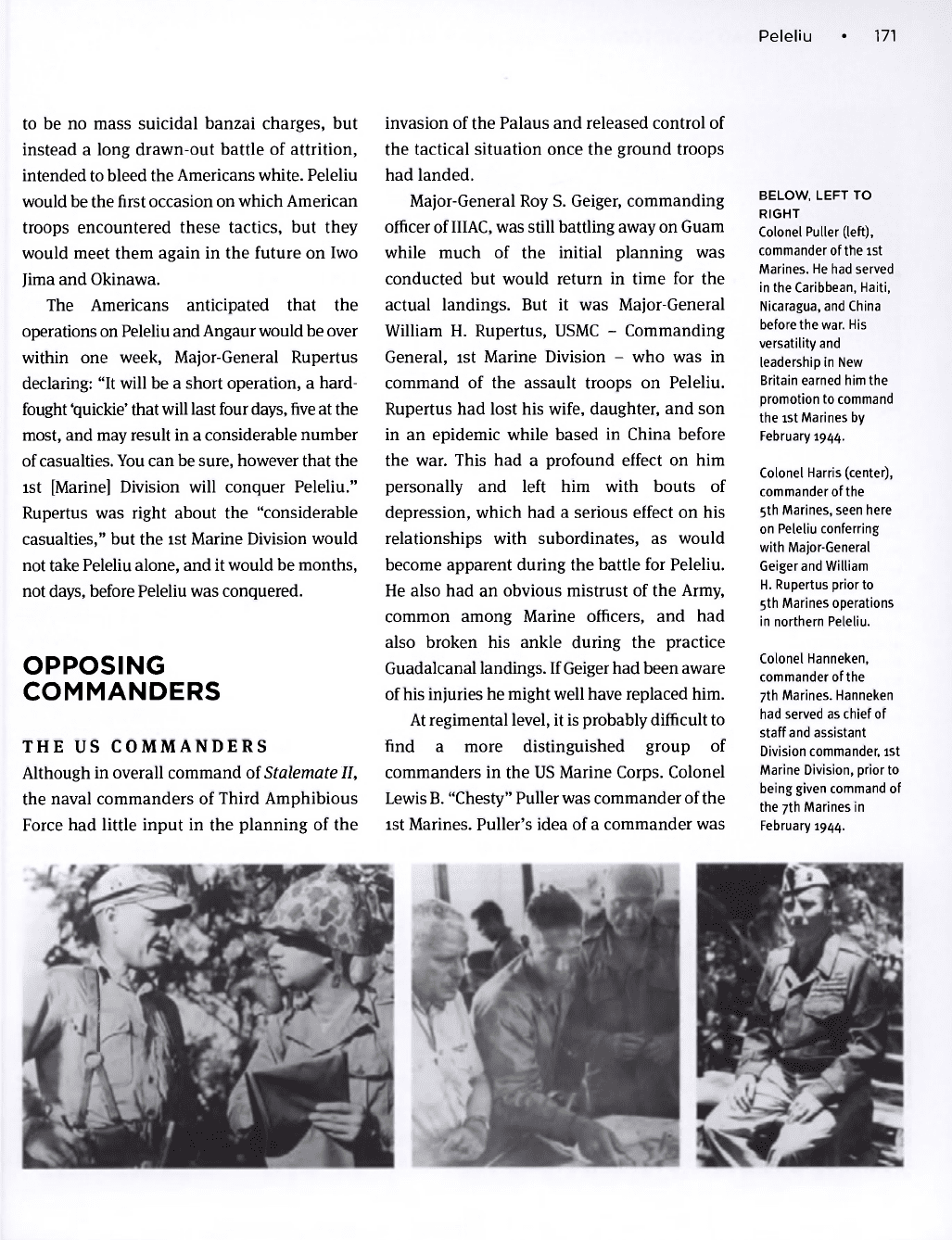
Peleliu • 171
BELOW, LEFT TO
RIGHT
Colonel Puller (left),
commander of the ist
Marines. He had served
in the Caribbean, Haiti,
Nicaragua, and China
before the war. His
versatility and
leadership in New
Britain earned him the
promotion to command
the ist Marines by
February 1944.
Colonel Harris (center),
commander of the
5th Marines, seen here
on Peleliu conferring
with Major-General
Geiger and William
H. Rupertus prior to
5th Marines operations
in northern Peleliu.
Colonel Hanneken,
commander of the
7th Marines. Hanneken
had served as chief of
staff and assistant
Division commander, 1st
Marine Division, prior to
being given command of
the 7th Marines in
February 1944.
to be no mass suicidal banzai charges, but
instead a long drawn-out battle of attrition,
intended to bleed the Americans white. Peleliu
would be the first occasion on which American
troops encountered these tactics, but they
would meet them again in the future on Iwo
Jima and Okinawa.
The Americans anticipated that the
operations on Peleliu and Angaur would be over
within one week, Major-General Rupertus
declaring: "It will be a short operation, a hard-
fought 'quickie' that will last four days, five at the
most, and may result in a considerable number
of casualties. You can be sure, however that the
1st [Marine] Division will conquer Peleliu."
Rupertus was right about the "considerable
casualties," but the 1st Marine Division would
not take Peleliu alone, and it would be months,
not days, before Peleliu was conquered.
OPPOSING
COMMANDERS
invasion of the Palaus and released control of
the tactical situation once the ground troops
had landed.
Major-General Roy S. Geiger, commanding
officer
of IIIAC, was still battling away on Guam
while much of the initial planning was
conducted but would return in time for the
actual landings. But it was Major-General
William H. Rupertus, USMC - Commanding
General, 1st Marine Division - who was in
command of the assault troops on Peleliu.
Rupertus had lost his wife, daughter, and son
in an epidemic while based in China before
the war. This had a profound effect on him
personally and left him with bouts of
depression, which had a serious effect on his
relationships with subordinates, as would
become apparent during the battle for Peleliu.
He also had an obvious mistrust of the Army,
common among Marine officers, and had
also broken his ankle during the practice
Guadalcanal landings. If Geiger had been aware
of his injuries he might well have replaced him.
At regimental level, it is probably
difficult
to
find a more distinguished group of
commanders in the US Marine Corps. Colonel
Lewis B. "Chesty" Puller was commander of the
1st Marines. Puller's idea of a commander was
THE US COMMANDERS
Although in overall command of Stalemate II,
the naval commanders of Third Amphibious
Force had little input in the planning of the
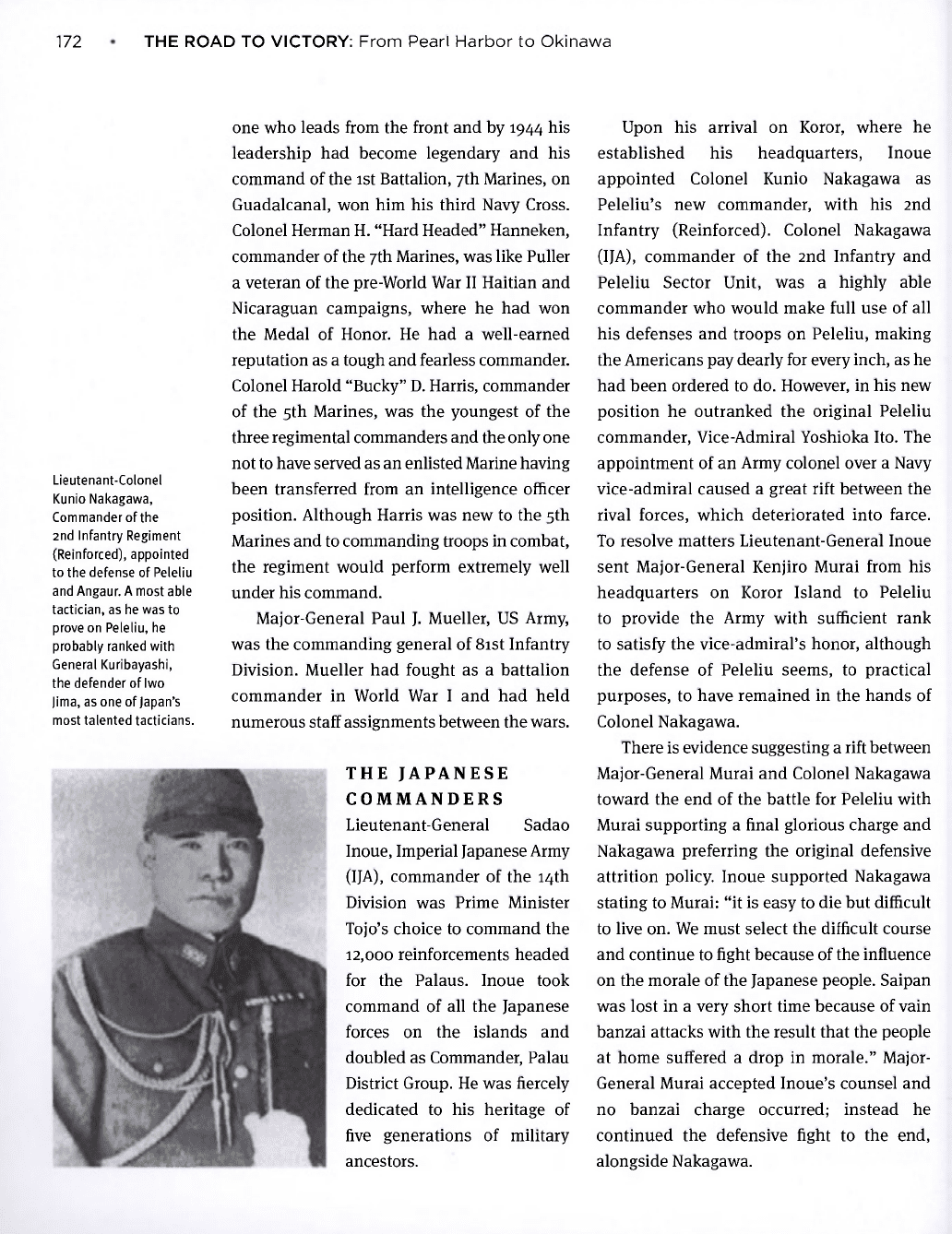
172 •
THE ROAD TO VICTORY: From Pearl Harbor to Okinawa
Lieutenant-Colonel
Kunio Nakagawa,
Commander of the
2nd Infantry Regiment
(Reinforced), appointed
to the defense of Peleliu
and Angaur. A most able
tactician, as he was to
prove on Peleliu, he
probably ranked with
General Kuribayashi,
the defender of Iwo
Jima, as one of japan's
most talented tacticians.
one who leads from the front and by 1944 his
leadership had become legendary and his
command of the 1st Battalion, 7th Marines, on
Guadalcanal, won him his third Navy Cross.
Colonel Herman H. "Hard Headed" Hanneken,
commander of the 7th Marines, was like Puller
a veteran of the pre-World War II Haitian and
Nicaraguan campaigns, where he had won
the Medal of Honor. He had a well-earned
reputation as a tough and fearless commander.
Colonel Harold "Bucky" D. Harris, commander
of the 5th Marines, was the youngest of the
three regimental commanders and the only one
not to have served as an enlisted Marine having
been transferred from an intelligence officer
position. Although Harris was new to the 5th
Marines and to commanding troops in combat,
the regiment would perform extremely well
under his command.
Major-General Paul J. Mueller, US Army,
was the commanding general of 81st Infantry
Division. Mueller had fought as a battalion
commander in World War I and had held
numerous staff assignments between the wars.
THE JAPANESE
COMMANDERS
Lieutenant-General Sadao
Inoue, Imperial Japanese Army
(IJA), commander of the 14th
Division was Prime Minister
Tojo's choice to command the
12,000 reinforcements headed
for the Palaus. Inoue took
command of all the Japanese
forces on the islands and
doubled as Commander, Palau
District Group. He was fiercely
dedicated to his heritage of
five generations of military
ancestors.
Upon his arrival on Koror, where he
established his headquarters, Inoue
appointed Colonel Kunio Nakagawa as
Peleliu's new commander, with his 2nd
Infantry (Reinforced). Colonel Nakagawa
(IJA), commander of the 2nd Infantry and
Peleliu Sector Unit, was a highly able
commander who would make full use of all
his defenses and troops on Peleliu, making
the Americans pay dearly for every inch, as he
had been ordered to do. However, in his new
position he outranked the original Peleliu
commander, Vice-Admiral Yoshioka Ito. The
appointment of an Army colonel over a Navy
vice-admiral caused a great rift between the
rival forces, which deteriorated into farce.
To resolve matters Lieutenant-General Inoue
sent Major-General Kenjiro Murai from his
headquarters on Koror Island to Peleliu
to provide the Army with sufficient rank
to satisfy the vice-admiral's honor, although
the defense of Peleliu seems, to practical
purposes, to have remained in the hands of
Colonel Nakagawa.
There is evidence suggesting a rift between
Major-General Murai and Colonel Nakagawa
toward the end of the battle for Peleliu with
Murai supporting a final glorious charge and
Nakagawa preferring the original defensive
attrition policy. Inoue supported Nakagawa
stating to Murai: "it is easy to die but difficult
to live on. We must select the difficult course
and continue to fight because of the influence
on the morale of the Japanese people. Saipan
was lost in a very short time because of vain
banzai attacks with the result that the people
at home suffered a drop in morale." Major-
General Murai accepted Inoue's counsel and
no banzai charge occurred; instead he
continued the defensive fight to the end,
alongside Nakagawa.
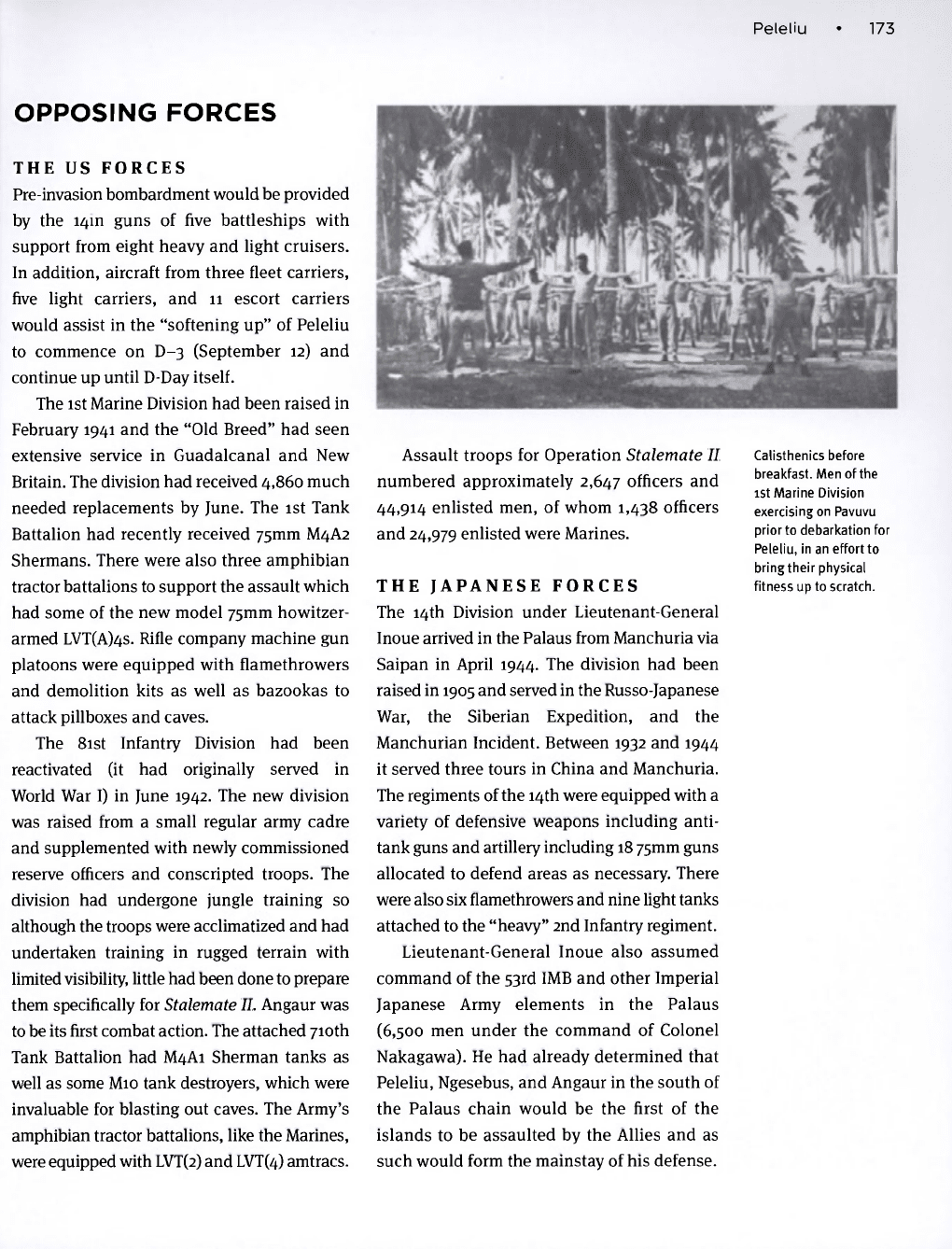
Peleliu • 173
OPPOSING FORCES
THE US FORCES
Pre-invasion bombardment would be provided
by the 14m guns of five battleships with
support from eight heavy and light cruisers.
In addition, aircraft from three fleet carriers,
five light carriers, and 11 escort carriers
would assist in the "softening up" of Peleliu
to commence on D-3 (September 12) and
continue up until D-Day itself.
The 1st Marine Division had been raised in
February 1941 and the "Old Breed" had seen
extensive service in Guadalcanal and New
Britain. The division had received 4,860 much
needed replacements by June. The 1st Tank
Battalion had recently received 75mm M4A2
Shermans. There were also three amphibian
tractor battalions to support the assault which
had some of the new model 75mm howitzer-
armed LVT(A)4S. Rifle company machine gun
platoons were equipped with flamethrowers
and demolition kits as well as bazookas to
attack pillboxes and caves.
The 81st Infantry Division had been
reactivated (it had originally served in
World War I) in June 1942. The new division
was raised from a small regular army cadre
and supplemented with newly commissioned
reserve officers and conscripted troops. The
division had undergone jungle training so
although the troops were acclimatized and had
undertaken training in rugged terrain with
limited visibility, little had been done to prepare
them specifically for Stalemate II. Angaur was
to be its first combat action. The attached 710th
Tank Battalion had M4A1 Sherman tanks as
well as some M10 tank destroyers, which were
invaluable for blasting out caves. The Army's
amphibian tractor battalions, like the Marines,
were equipped with LVT(2) and LVT(4) amtracs.
Assault troops for Operation Stalemate II
numbered approximately 2,647 officers and
44,914 enlisted men, of whom 1,438 officers
and 24,979 enlisted were Marines.
THE JAPANESE FORCES
The 14th Division under Lieutenant-General
Inoue arrived in the Palaus from Manchuria via
Saipan in April 1944. The division had been
raised in 1905 and served in the Russo-Japanese
War, the Siberian Expedition, and the
Manchurian Incident. Between 1932 and 1944
it served three tours in China and Manchuria.
The regiments of the 14th were equipped with a
variety of defensive weapons including anti-
tank guns and artillery including 18 75mm guns
allocated to defend areas as necessary. There
were also six flamethrowers and nine light tanks
attached to the "heavy" 2nd Infantry regiment.
Lieutenant-General Inoue also assumed
command of the 53rd 1MB and other Imperial
Japanese Army elements in the Palaus
(6,500 men under the command of Colonel
Nakagawa). He had already determined that
Peleliu, Ngesebus, and Angaur in the south of
the Palaus chain would be the first of the
islands to be assaulted by the Allies and as
such would form the mainstay of his defense.
Calisthenics before
breakfast. Men of the
1st Marine Division
exercising on Pavuvu
prior to debarkation for
Peleliu, in an effort to
bring their physical
fitness up to scratch.
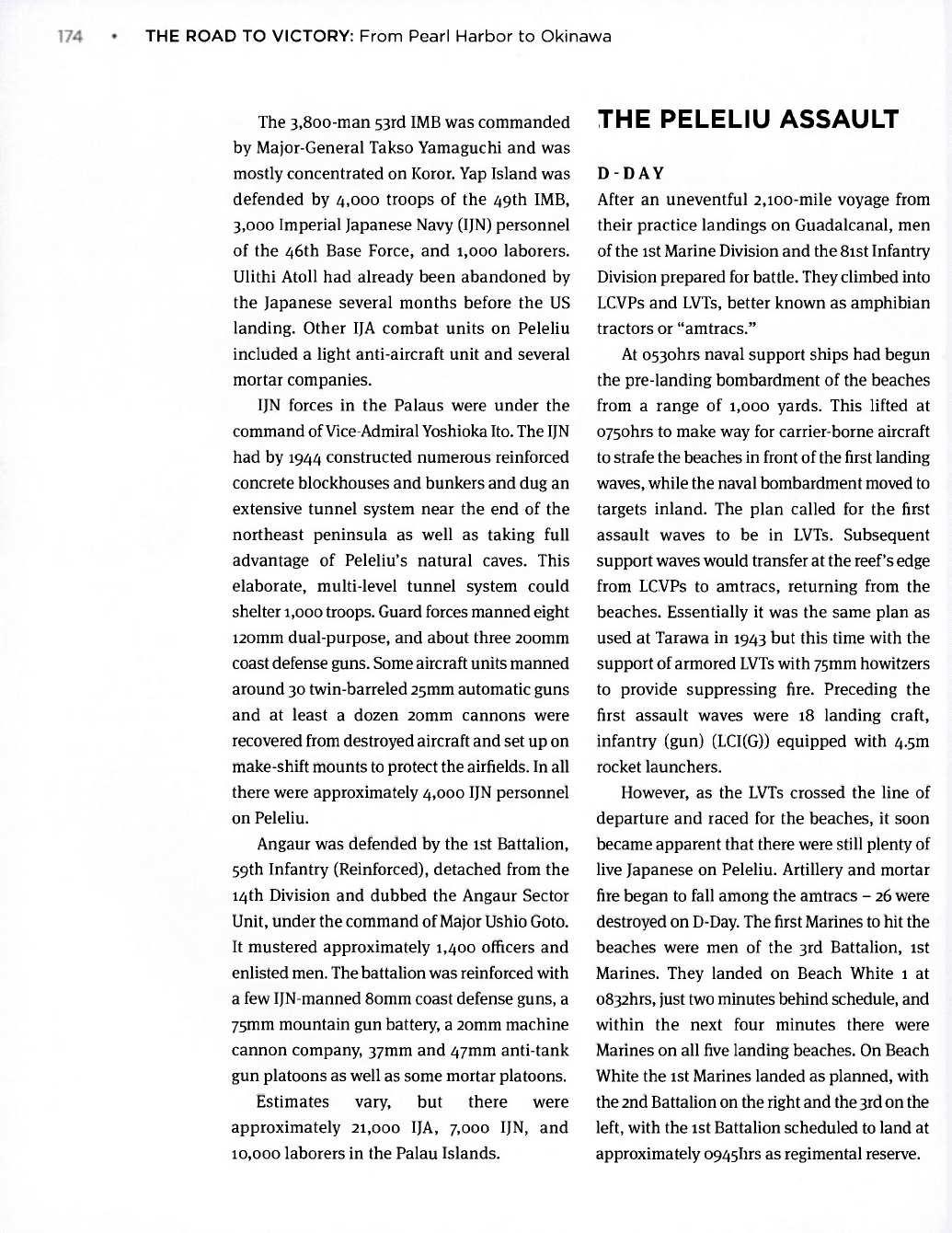
278 • THE ROAD TO VICTORY: From Pearl Harbor to Okinawa
The 3,800-man 53rd 1MB was commanded
by Major-General Takso Yamaguchi and was
mostly concentrated on Koror. Yap Island was
defended by 4,000 troops of the 49th 1MB,
3,000 Imperial Japanese Navy (IJN) personnel
of the 46th Base Force, and 1,000 laborers.
Ulithi Atoll had already been abandoned by
the Japanese several months before the US
landing. Other IJA combat units on Peleliu
included a light anti-aircraft unit and several
mortar companies.
IJN forces in the Palaus were under the
command of Vice-Admiral Yoshioka Ito. The IJN
had by 1944 constructed numerous reinforced
concrete blockhouses and bunkers and dug an
extensive tunnel system near the end of the
northeast peninsula as well as taking full
advantage of Peleliu's natural caves. This
elaborate, multi-level tunnel system could
shelter 1,000 troops. Guard forces manned eight
120mm dual-purpose, and about three 200mm
coast defense guns. Some aircraft units manned
around 30 twin-barreled 25mm automatic guns
and at least a dozen 20mm cannons were
recovered from destroyed aircraft and set up on
make-shift mounts to protect the airfields. In all
there were approximately 4,000 IJN personnel
on Peleliu.
Angaur was defended by the 1st Battalion,
59th Infantry (Reinforced), detached from the
14th Division and dubbed the Angaur Sector
Unit, under the command of Major Ushio Goto.
It mustered approximately 1,400 officers and
enlisted men. The battalion was reinforced with
a few IJN-manned 80mm coast defense guns, a
75mm mountain gun battery, a 20mm machine
cannon company, 37mm and 47mm anti-tank
gun platoons as well as some mortar platoons.
Estimates vary, but there were
approximately 21,000 IJA, 7,000 IJN, and
10,000 laborers in the Palau Islands.
THE PELELIU ASSAULT
D-DAY
After an uneventful 2,100-mile voyage from
their practice landings on Guadalcanal, men
of the 1st Marine Division and the 81st Infantry
Division prepared for battle. They climbed into
LCVPs and LVTs, better known as amphibian
tractors or "amtracs."
At 0530hrs naval support ships had begun
the pre-landing bombardment of the beaches
from a range of 1,000 yards. This lifted at
0750hrs to make way for carrier-borne aircraft
to strafe the beaches in front of the first landing
waves, while the naval bombardment moved to
targets inland. The plan called for the first
assault waves to be in LVTs. Subsequent
support waves would transfer at the reef's edge
from LCVPs to amtracs, returning from the
beaches. Essentially it was the same plan as
used at Tarawa in 1943 but this time with the
support of armored LVTs with 75mm howitzers
to provide suppressing fire. Preceding the
first assault waves were 18 landing craft,
infantry (gun) (LCI(G)) equipped with 4.5m
rocket launchers.
However, as the LVTs crossed the line of
departure and raced for the beaches, it soon
became apparent that there were still plenty of
live Japanese on Peleliu. Artillery and mortar
fire began to fall among the amtracs - 26 were
destroyed on D-Day. The first Marines to hit the
beaches were men of the 3rd Battalion, 1st
Marines. They landed on Beach White 1 at
o832hrs, just two minutes behind schedule, and
within the next four minutes there were
Marines on all five landing beaches. On Beach
White the 1st Marines landed as planned, with
the 2nd Battalion on the right and the 3rd on the
left, with the 1st Battalion scheduled to land at
approximately 0945IUS as regimental reserve.
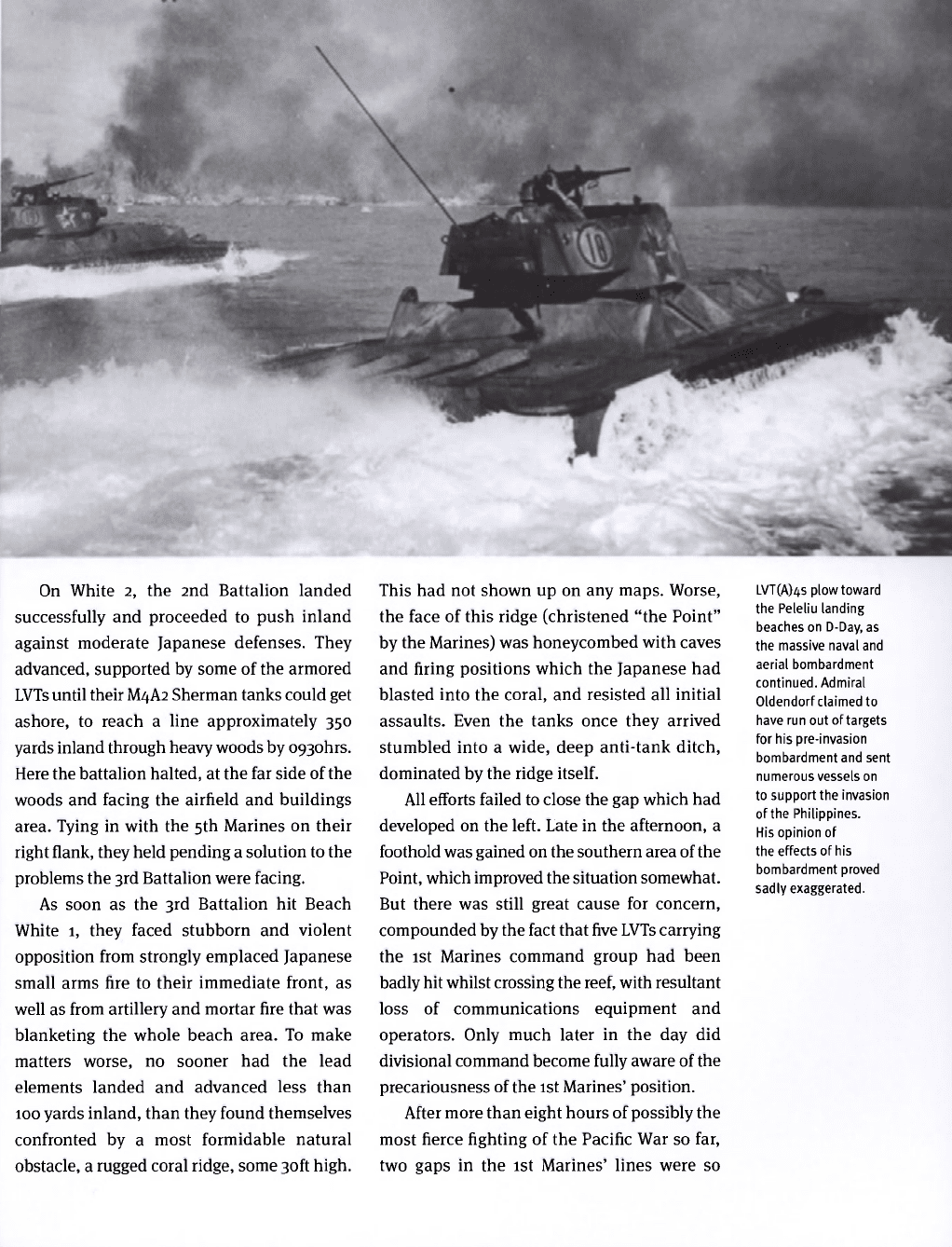
On White 2, the 2nd Battalion landed
successfully and proceeded to push inland
against moderate Japanese defenses. They
advanced, supported by some of the armored
LVTs until their M4A2 Sherman tanks could get
ashore, to reach a line approximately 350
yards inland through heavy woods by 0930hrs.
Here the battalion halted, at the far side of the
woods and facing the airfield and buildings
area. Tying in with the 5th Marines on their
right flank, they held pending a solution to the
problems the 3rd Battalion were facing.
As soon as the 3rd Battalion hit Beach
White 1, they faced stubborn and violent
opposition from strongly emplaced Japanese
small arms fire to their immediate front, as
well as from artillery and mortar fire that was
blanketing the whole beach area. To make
matters worse, no sooner had the lead
elements landed and advanced less than
100 yards inland, than they found themselves
confronted by a most formidable natural
obstacle, a rugged coral ridge, some 30ft high.
This had not shown up on any maps. Worse,
the face of this ridge (christened "the Point"
by the Marines) was honeycombed with caves
and firing positions which the Japanese had
blasted into the coral, and resisted all initial
assaults. Even the tanks once they arrived
stumbled into a wide, deep anti-tank ditch,
dominated by the ridge itself.
All efforts failed to close the gap which had
developed on the left. Late in the afternoon, a
foothold was gained on the southern area of the
Point, which improved the situation somewhat.
But there was still great cause for concern,
compounded by the fact that five LVTs carrying
the 1st Marines command group had been
badly hit whilst crossing the reef, with resultant
loss of communications equipment and
operators. Only much later in the day did
divisional command become fully aware of the
precariousness of the 1st Marines' position.
After more than eight hours of possibly the
most fierce fighting of the Pacific War so far,
two gaps in the 1st Marines' lines were so
LVT(A)4S plow toward
the Peleliu landing
beaches on D-Day, as
the massive naval and
aerial bombardment
continued. Admiral
Oldendorf claimed to
have run out of targets
for his pre-invasion
bombardment and sent
numerous vessels on
to support the invasion
of the Philippines.
His opinion of
the effects of his
bombardment proved
sadly exaggerated.
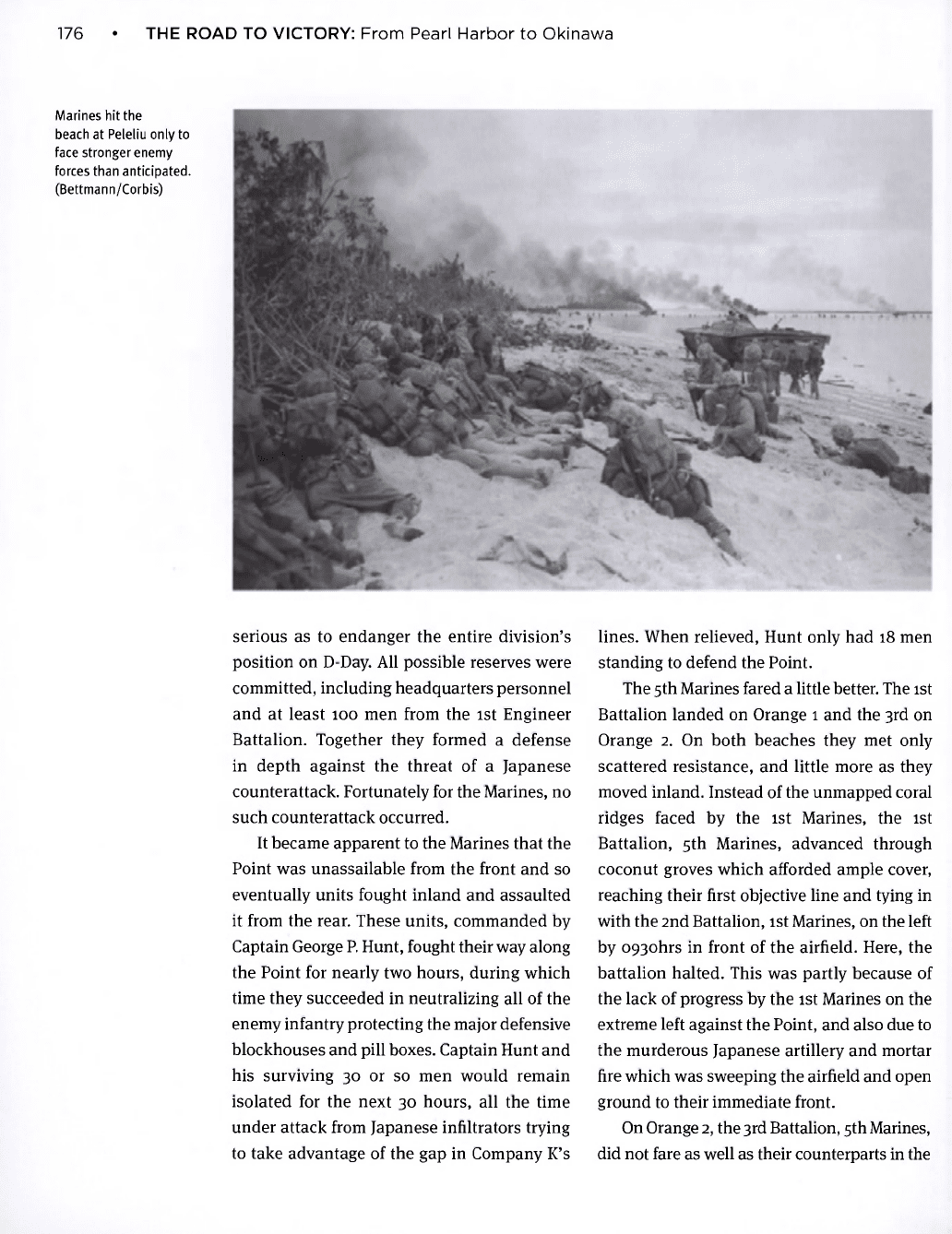
176 • THE ROAD TO VICTORY: From Pearl Harbor to Okinawa
Marines hit the
beach at Peleliu only to
face stronger enemy
forces than anticipated.
(Bettmann/Corbis)
serious as to endanger the entire division's
position on D-Day. All possible reserves were
committed, including headquarters personnel
and at least 100 men from the ist Engineer
Battalion. Together they formed a defense
in depth against the threat of a Japanese
counterattack. Fortunately for the Marines, no
such counterattack occurred.
It became apparent to the Marines that the
Point was unassailable from the front and so
eventually units fought inland and assaulted
it from the rear. These units, commanded by
Captain George
P.
Hunt, fought their way along
the Point for nearly two hours, during which
time they succeeded in neutralizing all of the
enemy infantry protecting the major defensive
blockhouses and pill boxes. Captain Hunt and
his surviving 30 or so men would remain
isolated for the next 30 hours, all the time
under attack from Japanese infiltrators trying
to take advantage of the gap in Company K's
lines. When relieved, Hunt only had 18 men
standing to defend the Point.
The 5th Marines fared a little better. The 1st
Battalion landed on Orange 1 and the 3rd on
Orange 2. On both beaches they met only
scattered resistance, and little more as they
moved inland. Instead of the unmapped coral
ridges faced by the 1st Marines, the 1st
Battalion, 5th Marines, advanced through
coconut groves which afforded ample cover,
reaching their first objective line and tying in
with the 2nd Battalion, 1st Marines, on the left
by 0930hrs in front of the airfield. Here, the
battalion halted. This was partly because of
the lack of progress by the 1st Marines on the
extreme left against the Point, and also due to
the murderous Japanese artillery and mortar
fire which was sweeping the airfield and open
ground to their immediate front.
On Orange 2, the 3rd Battalion, 5th Marines,
did not fare as well as their counterparts in the
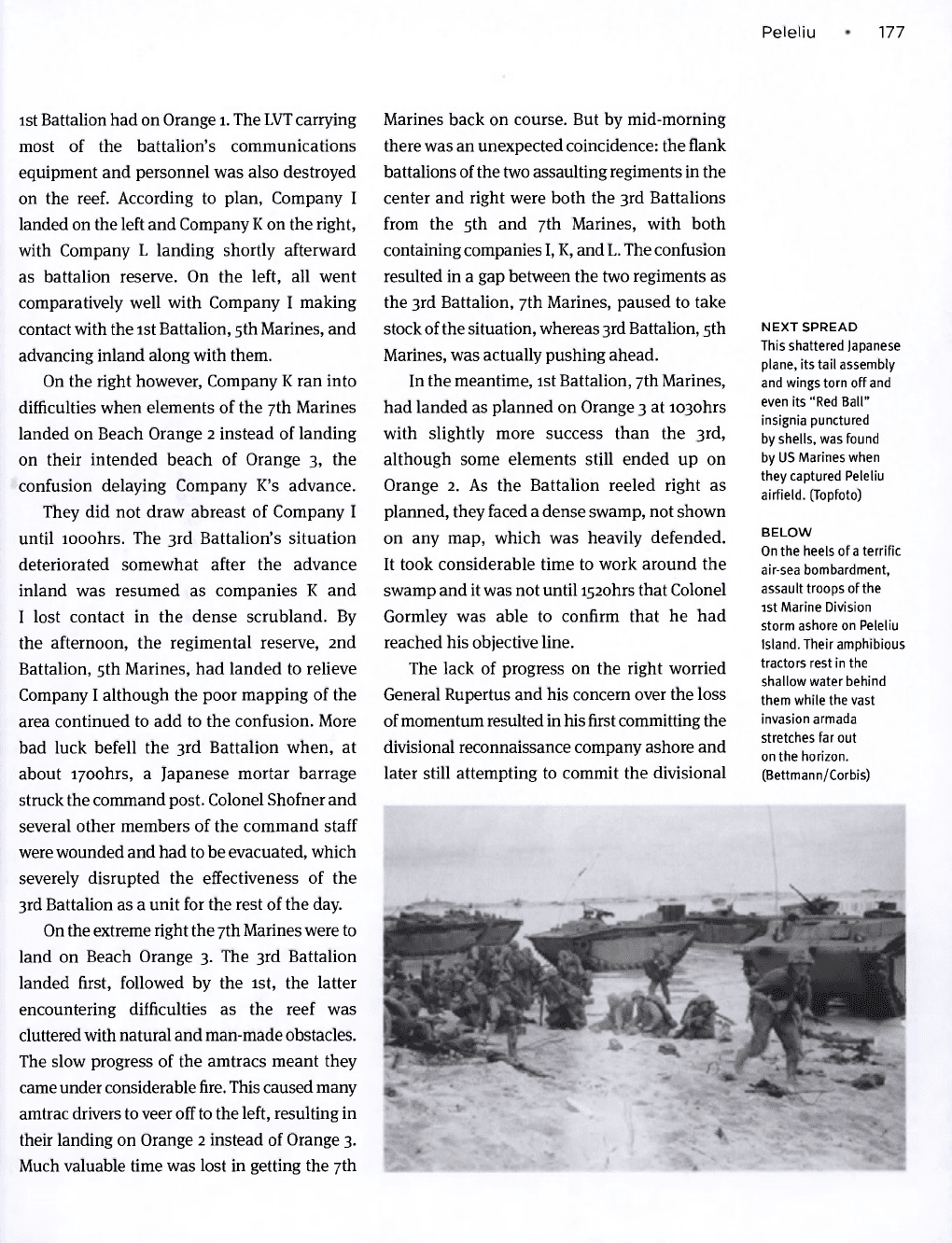
Peleliu •
177
ist Battalion had on Orange 1. The LVT carrying
most of the battalion's communications
equipment and personnel was also destroyed
on the reef. According to plan, Company I
landed on the left and Company K on the right,
with Company L landing shortly afterward
as battalion reserve. On the left, all went
comparatively well with Company I making
contact with the ist Battalion, 5th Marines, and
advancing inland along with them.
On the right however, Company K ran into
difficulties when elements of the 7th Marines
landed on Beach Orange 2 instead of landing
on their intended beach of Orange 3, the
confusion delaying Company K's advance.
They did not draw abreast of Company I
until looohrs. The 3rd Battalion's situation
deteriorated somewhat after the advance
inland was resumed as companies K and
I lost contact in the dense scrubland. By
the afternoon, the regimental reserve, 2nd
Battalion, 5th Marines, had landed to relieve
Company I although the poor mapping of the
area continued to add to the confusion. More
bad luck befell the 3rd Battalion when, at
about i700hrs, a Japanese mortar barrage
struck the command post. Colonel Shofner and
several other members of the command staff
were wounded and had to be evacuated, which
severely disrupted the effectiveness of the
3rd Battalion as a unit for the rest of the day.
On the extreme right the 7th Marines were to
land on Beach Orange 3. The 3rd Battalion
landed first, followed by the 1st, the latter
encountering difficulties as the reef was
cluttered with natural and man-made obstacles.
The slow progress of the amtracs meant they
came under considerable fire. This caused many
amtrac drivers to veer off
to
the
left,
resulting in
their landing on Orange 2 instead of Orange 3.
Much valuable time was lost in getting the 7th
Marines back on course. But by mid-morning
there was an unexpected coincidence: the flank
battalions of the two assaulting regiments in the
center and right were both the 3rd Battalions
from the 5th and 7th Marines, with both
containing companies I, K, and L. The confusion
resulted in a gap between the two regiments as
the 3rd Battalion, 7th Marines, paused to take
stock of the situation, whereas 3rd Battalion, 5th
Marines, was actually pushing ahead.
In the meantime, 1st Battalion, 7th Marines,
had landed as planned on Orange 3 at i030hrs
with slightly more success than the 3rd,
although some elements still ended up on
Orange 2. As the Battalion reeled right as
planned, they faced a dense swamp, not shown
on any map, which was heavily defended.
It took considerable time to work around the
swamp and it was not until i52ohrs that Colonel
Gormley was able to confirm that he had
reached his objective line.
The lack of progress on the right worried
General Rupertus and his concern over the loss
of momentum resulted in his first committing the
divisional reconnaissance company ashore and
later still attempting to commit the divisional
NEXT SPREAD
This shattered Japanese
plane, its tail assembly
and wings torn off and
even its "Red Ball"
insignia punctured
by shells, was found
by US Marines when
they captured Peleliu
airfield. (Topfoto)
BELOW
On the heels of a terrific
air-sea bombardment,
assault troops of the
1st Marine Division
storm ashore on Peleliu
Island. Their amphibious
tractors rest in the
shallow water behind
them while the vast
invasion armada
stretches far out
on the horizon.
(Bettmann/Corbis)
